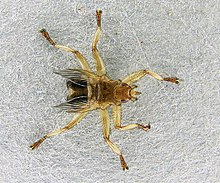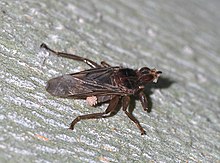Hippoboscidae
| Hippoboscidae | |
|---|---|
 | |
| The flightless Crataerina pallida | |
| Scientific classification | |
| Domain: | Eukaryota |
| Kingdom: | Animalia |
| Phylum: | Arthropoda |
| Class: | Insecta |
| Order: | Diptera |
| (unranked): | Eremoneura |
| (unranked): | Cyclorrhapha |
| Section: | Schizophora |
| Subsection: | Calyptratae |
| Superfamily: | Hippoboscoidea |
| Family: | Hippoboscidae Samouelle, 1819 |
| Subfamilies | |
| |
| Synonyms | |
| Hypoboscidae (lapsus) | |
Hippoboscidae, the louse flies or keds, are obligate parasites of mammals and birds. In this family, the winged species can fly at least reasonably well, though others with vestigial or no wings are flightless and highly apomorphic. As usual in their superfamily Hippoboscoidea, most of the larval development takes place within the mother's body, and pupation occurs almost immediately.[2]

The sheep ked, Melophagus ovinus, is a wingless, reddish-brown fly that parasitizes sheep. The Neotropical deer ked, Lipoptena mazamae, is a common ectoparasite of white-tailed deer (Odocoileus virginianus) in the southeastern United States. Both winged and wingless forms may be seen. A common winged species is Hippobosca equina, called "the louse fly" among riders. Species in other genera are found on birds; for example, Ornithomya bequaerti has been collected from birds in Alaska. Two species of the Hippoboscidae – Ornithoica (Ornithoica) podargi and Ornithomya fuscipennis are also common parasites of the tawny frogmouth (Podargus strigoides) of Australia.
Pseudolynchia canariensis is commonly found on pigeons and doves, and can serve as the vector of "pigeon malaria". Louse flies of birds may transmit other parasites such as those in the genus Plasmodium or other Haemoproteus parasites. Some evidence indicates that other Hippoboscidae can serve as vectors of disease agents to mammals. For example, a louse fly of the species Icosta americana was found with West Nile Virus infection from an American Kestrel.[3]
Systematics
In some obsolete taxonomies, the name Hippoboscidae is applied to the group properly known as Pupipara, i.e. the present family plus the bat flies (Nycteribiidae and "Streblidae"). They are called pupipara because the females birth live young, one at a time, that are deposited as late stage larvae called a prepuparium that pupate immediately at birth.[4][5][6] For the species Pseudolynchia canariensis, as well as other louse flies, reproduction is energetically expensive. Larvae feed on milk glands within the female fly prior to being deposited. Single offspring (pupae) can weigh more than an unfed emerged adult fly since the pupal casing is included in the pupal weight and teneral flies often put on mass after their first few blood meals.[7] Two of the three traditional subfamilies (Hippoboscinae and Lipopteninae) have been shown to be good monophyletic groups at least overall. According to cladistic analysis of several DNA sequences, to make the Ornithomyinae monophyletic, their tribe Olfersini deserves to be recognized as a full family, too.[8][9]
- Subfamily Ornithomyinae Bigot, 1853
- Genus Allobosca Speiser, 1899 (1 species)
- Genus Austrolfersia Bequaert, 1953 (1 species)
- Genus Crataerina von Olfers, 1816 (8 species)
- Genus Icosta Speiser, 1905 (52 species)
- Genus Microlynchia Lutz, 1915 (4 species)
- Genus Myophthiria Rondani, 1875 (13 species)
- Genus Olfersia Leach, 1817 (7 species)
- Genus Ornithoctona Speiser, 1902 (12 species)
- Genus Ornithoica Rondani, 1878 (24 species)
- Genus Ornithomya Latreille, 1802 (29 species)
- Genus Ornithophila Rondani, 1879 (2 species)
- Genus Ortholfersia Speiser, 1902 (4 species)
- Genus Phthona Maa, 1969 (3 species)
- Genus Proparabosca Theodor & Oldroyd 1965 (1 species)
- Genus Pseudolynchia Bequaert, 1926 (5 species)
- Genus Stilbometopa Coquillett, 1899 (5 species)
- Subfamily Hippoboscinae
- Genus Hippobosca Linnaeus, 1758 (7 species)
- Genus Struthiobosca Maa, 1963[10] (1 species)
- Subfamily Lipopteninae
- Genus Lipoptena Nitzsch, 1818 (30 species)
- Genus Melophagus Latreille, 1802 (3 species)
- Genus Neolipoptena Bequaert, 1942 (1 species)
See also
References
- ^ Maa, T. C. (1969). "A Revised Checklist and Concise Host Index of Hippoboscidae (Diptera)" (PDF). Pacific Insects Monograph. 20. Honolulu: Bishop Museum, Honolulu, Hawaii: 261–299.
- ^ Hutson, A.M (1984). Diptera: Keds, flat-flies & bat-flies (Hippoboscidae & Nycteribiidae). Handbooks for the Identification of British Insects. Vol. 10 pt 7. Royal Entomological Society of London. p. 84.
- ^ Bó, M. Susana; Cabezas, Sonia; Martínez, Pablo; Sarasola, José H.; Cicchino, Armando C.; Santillán, Miguel Á; Liébana, M. Soledad (2011). "Ectoparasites In Free-Ranging American Kestrels In Argentina: Implications for the Transmission of Viral Diseases". Journal of Raptor Research. 45 (4): 335–342. doi:10.3356/JRR-11-26.1. hdl:11336/81706. ISSN 0892-1016. S2CID 54918715.
- ^ Walker, Meredith Swett (2015-05-18). "Behold the Hippoboscidae: Bizarre Biting Flies that Give Live Birth!". Entomology Today. Retrieved 2019-02-10.
- ^ ZADBI: Zurqui All-Diptera Biodiversity Inventory: How to Identify Flies – Cyclorrhapha, on: phorid.net, 2013. See: Hippoboscidae (louse flies), Natural History
- ^ Joel Kits: Species Pseudolynchia canariensis - Pigeon Fly: Life Cycle, on BugGuide, 21 March 2005; cited by: Pigeon Louse Fly, we believe, om: What's That Bug
- ^ Waite, Jessica L.; Henry, Autumn R.; Adler, Frederick R.; Clayton, Dale H. (2012). "Sex-specific effects of an avian malaria parasite on an insect vector: support for the resource limitation hypothesis". Ecology. 93 (11): 2448–2455. doi:10.1890/11-2229.1. ISSN 1939-9170. PMID 23236915.
- ^ Petersen, Frederik Torp; Meier, Rudolf; Kutty, Sujatha Narayanan; Wiegmann, Brian M. . (October 2007). "The phylogeny and evolution of host choice in the Hippoboscoidea (Diptera) as reconstructed using four molecular markers". Molecular Phylogenetics and Evolution. 45 (1): 111–122. doi:10.1016/j.ympev.2007.04.023. PMID 17583536.
- ^ Dick, C. W. (20 December 2006). "Checklist of World Hippoboscidae (Diptera: Hippoboscoidea)" (PDF). Chicago: Department of Zoology, Field Museum of Natural History. Archived from the original (PDF) on 13 February 2012. Retrieved 8 June 2009.
- ^ Maa, T. C (1963). "Genera and species of Hippoboscidae (Diptera) types, synonymy, habitats and natural groupings" (PDF). Pacific Insects Monograph. 6: 1–186. Retrieved 12 April 2024.
External links

- [Jackson S. Whitman; Nixon Wilson (April–June 1992). "Incidence of Louse-flies (Hippoboscidae) in Some Alaskan Birds" (PDF). North American Bird Bander. 17 (2): 65–8.
- Sheep Ked
- Pigeon Louse Fly
- Pseudolychia canariensis as Vector of Pigeon Malaria
- Halos L, Jamal T, Maillard R, et al. (October 2004). "Role of Hippoboscidae flies as potential vectors of Bartonella spp. infecting wild and domestic ruminants". Appl. Environ. Microbiol. 70 (10): 6302–5. Bibcode:2004ApEnM..70.6302H. doi:10.1128/AEM.70.10.6302-6305.2004. PMC 522062. PMID 15466580.
- Photograph of A Louse Fly
- Images from Diptera.info.[1]
- Images from BugGuide [2]
- Pseudolychia canariensis, pigeon louse fly on the UF / IFAS Featured Creatures Web site
- Lipoptena mazamae, Neotropical deer ked on the UF / IFAS Featured Creatures Web site
- v
- t
- e
- Kingdom: Animalia
- Phylum: Arthropoda
- Class: Insecta
- Subclass: Pterygota
- Infraclass: Neoptera
- Superorder: Holometabola
Suborder Nematocera | |||||||||||||||||||||||||||||||||||||||||||||||||||
|---|---|---|---|---|---|---|---|---|---|---|---|---|---|---|---|---|---|---|---|---|---|---|---|---|---|---|---|---|---|---|---|---|---|---|---|---|---|---|---|---|---|---|---|---|---|---|---|---|---|---|---|
| |||||||||||||||||||||||||||||||||||||||||||||||||||
Suborder Brachycera | |||||||||||||||||||||||||||||||||||||||||||||||||||||||||||||||||||||||||||||||
|---|---|---|---|---|---|---|---|---|---|---|---|---|---|---|---|---|---|---|---|---|---|---|---|---|---|---|---|---|---|---|---|---|---|---|---|---|---|---|---|---|---|---|---|---|---|---|---|---|---|---|---|---|---|---|---|---|---|---|---|---|---|---|---|---|---|---|---|---|---|---|---|---|---|---|---|---|---|---|---|
| |||||||||||||||||||||||||||||||||||||||||||||||||||||||||||||||||||||||||||||||









